The Ultimate Guide To Product-Led Growth
The Ultimate Guide To Product-Led Growth
The Ultimate Guide To Product-Led Growth
Explore what product led growth is, its importance in SaaS, and how to become a product led growth company in three strategic steps.
Explore what product led growth is, its importance in SaaS, and how to become a product led growth company in three strategic steps.
Explore what product led growth is, its importance in SaaS, and how to become a product led growth company in three strategic steps.



Product-led growth (PLG) is a business model where your customers sign up and experience the product by themselves.
The customer success strategy is driven by the quality of your product rather than the persuasiveness of your sales team.
So if your customer is a driver, your product is the steering wheel helping them maneuver the various bumps and potholes on the way.

And a smooth ride can turn your customers into die-hard brand advocates and help you scale business profits.
Curious to learn more about PLG?
In this article, we’ll discover what product-led growth is, including its four amazing benefits. We’ll also compare PLG against other growth models and how PLG is calling the shots in the SaaS industry.
Finally, we’ll reveal how to become a high-performing PLG company in three steps.
Let’s go!
What is Product-Led Growth?
Product-led growth is a business methodology where your product is at the forefront of EVERYTHING.
Product-led companies aim to create a product that becomes their customer’s best friend – offering unique solutions and resolving their pain points.
There is minimal intervention by the sales team. Instead, the product shines through by delivering a terrific user experience and dropping fantastic updates from time to time.
However, the product wasn’t always the protagonist of the story.
In the early 2000s, the market was dominated by sales led growth companies.
The sales team met key decision makers over a fancy brunch 🥐🍹 or a game of golf 🏌️ to sell the product.
In the early 2010s, marketing led growth took over. Compelling marketing content (whitepapers, online campaigns, press releases, paid ads, etc.) was used to raise product awareness and encourage product usage.
However, with an increasing user base and stiff competition in the SaaS field, companies shifted gears from sales/marketing to product led growth.
And it's a trend surfacing across B2B as well as B2C companies.
They leverage technology to create a desirable product that matches customer expectations.
It has transformed the landscape of SaaS GTM and made PLG the #1 choice for businesses worldwide.
Users today are more motivated to convert from free trial users into paying customers when they experience product value directly.
Simply put, the product led growth strategy can maximize product adoption and drive positive customer feedback.
You make the sale without making a pushy or nervous sales call!

Sounds like a total win-win?
Wait till you check out the benefits of PLG.
Four Impressive Benefits of Product-Led Growth
Here are some benefits of implementing the product-led growth strategy:
1. Wider Pool of Customers
In a product-led strategy, the free trial or freemium plan gives your customers a chance to try your product before they buy.
As there’s no buy-in cost, they can sign up immediately.
A direct product experience helps users accurately gauge the product’s usefulness for themselves. As a result, you create a wider top funnel and improve your chances of acquiring a product qualified lead (PQL) from free trials.
As a bonus, your customers won't have to fill out tiresome demo requests before using your product. These forms often prevent customers from taking the next step toward product purchases.
Here’s how you can turn heads and drive sales with a powerful B2C product-led growth strategy.
2. Shorter Sales Cycles
Your users have engaged with your product, experienced the benefits, and evaluated its different features.
All for FREE.
Or definitely at a much lower price point than one would’ve imagined!
It motivates your customers to upgrade to a higher pricing plan and keep benefitting from your product.
The bottomline?
Your sales team needn’t repeatedly step in to push them towards the first purchase.
3. Better Profit Margins
With a product-led approach, you can reduce hiring and training costs for marketing, sales, and customer service teams. This, in turn, leads to increased revenue growth.
All you need is a high-functioning product management team to put together a kickass product that wows the customer!
4. Enhanced User Experience
While sales and marketing led growth can help you with customer acquisition, product-led growth can also help you with customer retention. It's because the product led approach prioritizes user experience.
In the PLG model, the product is designed with the end-user in mind. In fact, the user - not the CXO - makes the ultimate decisions about the product experience.
Hence, they don’t feel disappointed or deceived after paying for the product as they’ve already experienced its value.
But what about other growth models, and how do they compare against the PLG model?
Product-Led Growth vs. Other Growth Models: Foue Key Differentiators
Here are some ways in which the PLG model distinguishes itself against other growth models:
1) Product-Led Growth
2) Sales-Led Growth
3) Marketing-Led Growth
Point of Contact:
Self-service – customers use the product directly after getting to know about it from user referrals, content marketing, SEO, press, and similar channels.
Sales rep – implements cold email outreach, cold calling, etc., for customer acquisition.
Marketers – builds SEO content, prepares digital marketing campaigns, targeted ads, etc., to increase product awareness amongst the target audience.
Buying Cycle:
Shorter buying cycles, thanks to low barrier entry. The product takes on much of the sales, marketing, and customer service roles. Talk about donning many hats with ease! 🎩
Long sales process involving first sales meetings, product demos, handling customer objections, etc.
Buying cycles can be long or short, based on how quickly or slowly the customer engages with the product marketing material and decides to move further in the buying cycle.
Cost Efficiency:
High cost savings and a lower customer acquisition cost, as you don't require large sales and marketing teams in the product led approach.
Need to make constant investments in recruiting, training, and preparing sales scripts to keep the sales led company profitable.
A substantial amount of the company revenue is spent on product marketing efforts.
Best For:
Any SaaS company offering products with lower price points and having easy onboarding processes and monthly plans.
Software companies in industries that can’t be tackled through traditional marketing channels and can’t offer free trials to users.
Software companies with more expensive products or those that require a significant amount of customer education or consultative selling.
Here’s an in-depth comparison between product-led growth and sales led growth.
It’s pretty evident that a product led company can drive more sales in a lot less time.
As a product manager, you don’t have to stay stuck in long buying cycles.
Instead, you can hop, skip, and jump your way towards a successful quarter of sales. 🤸
Next, we’ll understand why product led growth strategy is paving the way for future SaaS companies.
Why is Product-Led Growth Shaping the Future of SaaS?
Complex SaaS products need bigger customer service teams to successfully convert potential leads into paid customers.
For sales led or marketing led companies, it can prove expensive as you’d need employees with niche expertise.
Alternately, if you hire inexperienced employees with inadequate product experience or invest in cheap technologies from the Stone Age, you’ll have a poor sales performance.
Seems like you either part ways with your money or customers! 😭

Unless…
You implement a product led growth model optimized to retain customers regardless of the sales or CS intervention.
The B2B buyer prefers self-service over a sales rep, which drives many SaaS companies to shift to a product led approach for better customer acquisition.
Check out the five brilliant tips to execute a mindblowing B2B product led growth strategy.
Further, a product led company is technically scalable.
Any SaaS product can serve users worldwide online without additional costs for crossing boundaries.
However, in a sales led company, the sales rep may have to travel to different places to make a convincing case for the product before any client or B2B buyer.
Ready to switch gears and implement a profitable product led strategy?
Here’s what you need to know as the product manager.
How to Become a Product-Led Growth Company in Three Steps
Here are some basic steps to begin your product-led growth journey:
1. Have a free or freemium trial stage for users
The trial stage is delightful for your users and insightful for your product team. They can closely assess what aspects of the product worked well or what didn’t make the cut.
If the number of users turning into paid customers from the free or freemium trial is way less than the industry standards, you need to focus on product development.
Your product growth team should continually evolve the product, add updates, features, and dimensions that make it worth your users’ time and money.
So the next time your users try the product, don’t give them the chance to go:

Here are some tips and tricks on developing a freemium pricing model that your buyers will love!
2. Prioritize Ease-of-Use
You should design your entire product experience to make things as user-friendly as possible. It means assisting users on the customer journey by:
Supporting them with user onboarding tutorials.
Constantly providing contextual in-app communications about new features, useful upsell prompts, etc.
Offering solutions that make their tasks faster, easier, less irritable…basically anything that stops them from feeling like 🤦 or 🙄.
Prioritizing customer experience also allows your product team to work on product development and introduce updates that can make a difference. After all, the goal is to show your buyers the value in purchasing the product you’re trying to sell.
Once you accomplish that, you can easily acquire a product qualified lead and improve customer retention in the long run.
3. Leverage behavioral analytics
Making data-driven decisions based on user behavior is critical to the success of any SaaS company. Especially if your business is based on product-led user experience.
Product-led companies can and should track every interaction between their product and users through behavioral analytics. User behavior like abandoning product trials midway can reveal to your product management team what your users find valuable and what they don’t.
But how can a PLG company track and assess all this user info?
With Toplyne!
Toplyne is a SaaS platform that can analyze complex patterns in large volumes of product data to identify users with the highest intent to convert to paid subscriptions.
In fact, the tool helps you classify your user base into different personas.

So your sales team can primarily focus on the promising users instead of wasting time chasing other leads that will never convert.
And that’s not all!
Toplyne can also help you in:
Here are some other ways Toplyne can help companies invested in the product led growth flywheel model:
Lets you determine the go-to market strategy (re-marketing/automated messaging/sales assist motion/in-product nudges) that will work best for each of your promising leads.

Quickly integrates with popular CRM tools (Salesforce, Hubspot) and product analytics infrastructures (Amplitude, Segment).
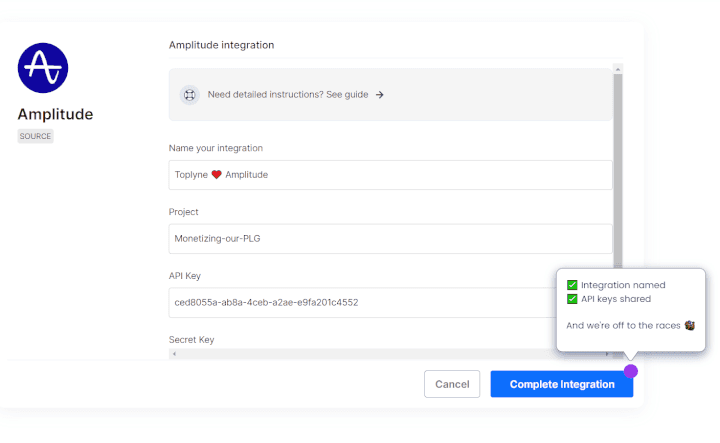
Helps you send all your PQLs (product qualified leads) to your chosen sales channel (email, Salesforce, Webhook, etc.)
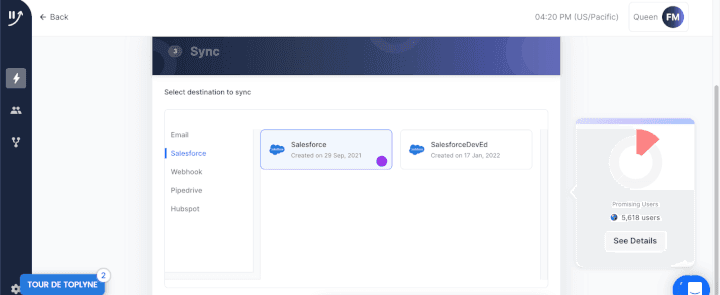
Crafts an in-product tailored customer experience to encourage users towards inviting more team members to scale product adoption easily.
In fact, Canva, Invideo, and OpenPhone are just some of the top SaaS companies that have monetized their product-led growth model using Toplyne.
Looking for inspiration to become a product-led sales company?
Borrow a leaf out of the book of these three companies that nailed it with their PLG strategy.
Three Companies That Mastered Product-Led Growth
Here are three companies that implemented PLG with much success:
1. Calendly
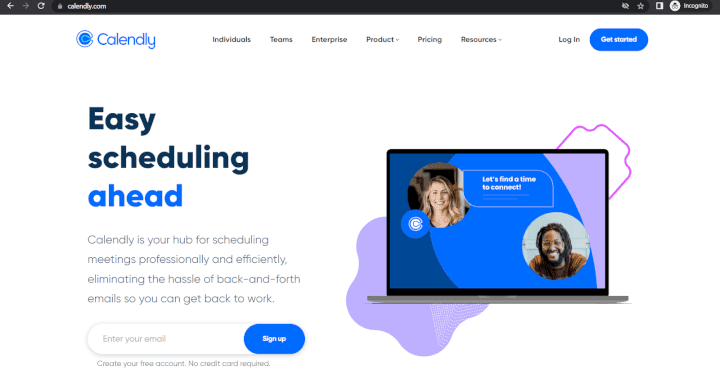
Calendly is a meeting scheduling tool designed for easy collaboration. Every time a user sends a meeting invite via Calendly, they automatically promote the product to the recipient and help the company get a new lead!
Now that’s the kind of meet cute PLG companies dream of. 🥰
Here’s a sneak peek into Calendly’s remarkable growth as a product led growth company!
2. Dropbox
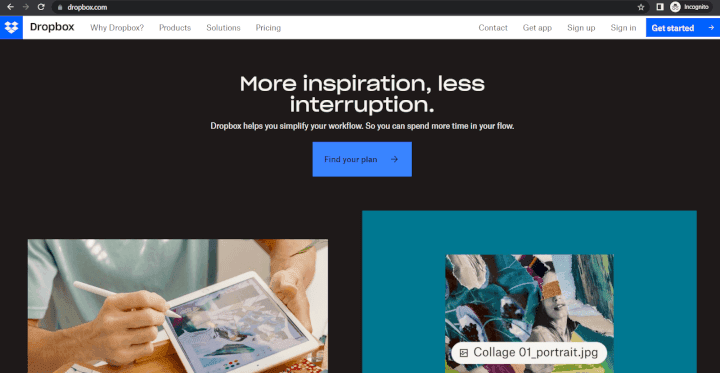
Dropbox is a digital tool for storing and sharing cloud content. The tool had introduced a referral program allowing users to increase their storage space by inviting new people to sign up.
3. Slack
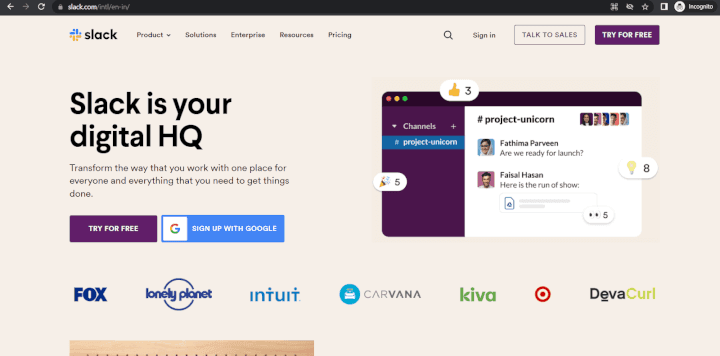
Slack is an effective business communication tool. Much of its success can be attributed to the tool’s easy usability. Users don’t have to take any software training separately to learn the ins and outs of this product. Definitely cutting them some slack. 😁
Level Up Your Game With Product-Led Growth
While it’s clear that the PLG strategy can help you create cutting-edge products and happier customers, the transition to PLG doesn’t happen overnight.
Go through the foundational steps we’ve listed here to kickstart your product led growth journey.
And race ahead of your competitors by choosing a platform like Toplyne.
It can help you save time and money spent on chasing leads that won’t convert. Instead, you can make customers come to you with a sophisticated product!
What are you waiting for?
Sign up for Toplyne for free today to take your business performance to the next level.

Product-led growth (PLG) is a business model where your customers sign up and experience the product by themselves.
The customer success strategy is driven by the quality of your product rather than the persuasiveness of your sales team.
So if your customer is a driver, your product is the steering wheel helping them maneuver the various bumps and potholes on the way.

And a smooth ride can turn your customers into die-hard brand advocates and help you scale business profits.
Curious to learn more about PLG?
In this article, we’ll discover what product-led growth is, including its four amazing benefits. We’ll also compare PLG against other growth models and how PLG is calling the shots in the SaaS industry.
Finally, we’ll reveal how to become a high-performing PLG company in three steps.
Let’s go!
What is Product-Led Growth?
Product-led growth is a business methodology where your product is at the forefront of EVERYTHING.
Product-led companies aim to create a product that becomes their customer’s best friend – offering unique solutions and resolving their pain points.
There is minimal intervention by the sales team. Instead, the product shines through by delivering a terrific user experience and dropping fantastic updates from time to time.
However, the product wasn’t always the protagonist of the story.
In the early 2000s, the market was dominated by sales led growth companies.
The sales team met key decision makers over a fancy brunch 🥐🍹 or a game of golf 🏌️ to sell the product.
In the early 2010s, marketing led growth took over. Compelling marketing content (whitepapers, online campaigns, press releases, paid ads, etc.) was used to raise product awareness and encourage product usage.
However, with an increasing user base and stiff competition in the SaaS field, companies shifted gears from sales/marketing to product led growth.
And it's a trend surfacing across B2B as well as B2C companies.
They leverage technology to create a desirable product that matches customer expectations.
It has transformed the landscape of SaaS GTM and made PLG the #1 choice for businesses worldwide.
Users today are more motivated to convert from free trial users into paying customers when they experience product value directly.
Simply put, the product led growth strategy can maximize product adoption and drive positive customer feedback.
You make the sale without making a pushy or nervous sales call!

Sounds like a total win-win?
Wait till you check out the benefits of PLG.
Four Impressive Benefits of Product-Led Growth
Here are some benefits of implementing the product-led growth strategy:
1. Wider Pool of Customers
In a product-led strategy, the free trial or freemium plan gives your customers a chance to try your product before they buy.
As there’s no buy-in cost, they can sign up immediately.
A direct product experience helps users accurately gauge the product’s usefulness for themselves. As a result, you create a wider top funnel and improve your chances of acquiring a product qualified lead (PQL) from free trials.
As a bonus, your customers won't have to fill out tiresome demo requests before using your product. These forms often prevent customers from taking the next step toward product purchases.
Here’s how you can turn heads and drive sales with a powerful B2C product-led growth strategy.
2. Shorter Sales Cycles
Your users have engaged with your product, experienced the benefits, and evaluated its different features.
All for FREE.
Or definitely at a much lower price point than one would’ve imagined!
It motivates your customers to upgrade to a higher pricing plan and keep benefitting from your product.
The bottomline?
Your sales team needn’t repeatedly step in to push them towards the first purchase.
3. Better Profit Margins
With a product-led approach, you can reduce hiring and training costs for marketing, sales, and customer service teams. This, in turn, leads to increased revenue growth.
All you need is a high-functioning product management team to put together a kickass product that wows the customer!
4. Enhanced User Experience
While sales and marketing led growth can help you with customer acquisition, product-led growth can also help you with customer retention. It's because the product led approach prioritizes user experience.
In the PLG model, the product is designed with the end-user in mind. In fact, the user - not the CXO - makes the ultimate decisions about the product experience.
Hence, they don’t feel disappointed or deceived after paying for the product as they’ve already experienced its value.
But what about other growth models, and how do they compare against the PLG model?
Product-Led Growth vs. Other Growth Models: Foue Key Differentiators
Here are some ways in which the PLG model distinguishes itself against other growth models:
1) Product-Led Growth
2) Sales-Led Growth
3) Marketing-Led Growth
Point of Contact:
Self-service – customers use the product directly after getting to know about it from user referrals, content marketing, SEO, press, and similar channels.
Sales rep – implements cold email outreach, cold calling, etc., for customer acquisition.
Marketers – builds SEO content, prepares digital marketing campaigns, targeted ads, etc., to increase product awareness amongst the target audience.
Buying Cycle:
Shorter buying cycles, thanks to low barrier entry. The product takes on much of the sales, marketing, and customer service roles. Talk about donning many hats with ease! 🎩
Long sales process involving first sales meetings, product demos, handling customer objections, etc.
Buying cycles can be long or short, based on how quickly or slowly the customer engages with the product marketing material and decides to move further in the buying cycle.
Cost Efficiency:
High cost savings and a lower customer acquisition cost, as you don't require large sales and marketing teams in the product led approach.
Need to make constant investments in recruiting, training, and preparing sales scripts to keep the sales led company profitable.
A substantial amount of the company revenue is spent on product marketing efforts.
Best For:
Any SaaS company offering products with lower price points and having easy onboarding processes and monthly plans.
Software companies in industries that can’t be tackled through traditional marketing channels and can’t offer free trials to users.
Software companies with more expensive products or those that require a significant amount of customer education or consultative selling.
Here’s an in-depth comparison between product-led growth and sales led growth.
It’s pretty evident that a product led company can drive more sales in a lot less time.
As a product manager, you don’t have to stay stuck in long buying cycles.
Instead, you can hop, skip, and jump your way towards a successful quarter of sales. 🤸
Next, we’ll understand why product led growth strategy is paving the way for future SaaS companies.
Why is Product-Led Growth Shaping the Future of SaaS?
Complex SaaS products need bigger customer service teams to successfully convert potential leads into paid customers.
For sales led or marketing led companies, it can prove expensive as you’d need employees with niche expertise.
Alternately, if you hire inexperienced employees with inadequate product experience or invest in cheap technologies from the Stone Age, you’ll have a poor sales performance.
Seems like you either part ways with your money or customers! 😭

Unless…
You implement a product led growth model optimized to retain customers regardless of the sales or CS intervention.
The B2B buyer prefers self-service over a sales rep, which drives many SaaS companies to shift to a product led approach for better customer acquisition.
Check out the five brilliant tips to execute a mindblowing B2B product led growth strategy.
Further, a product led company is technically scalable.
Any SaaS product can serve users worldwide online without additional costs for crossing boundaries.
However, in a sales led company, the sales rep may have to travel to different places to make a convincing case for the product before any client or B2B buyer.
Ready to switch gears and implement a profitable product led strategy?
Here’s what you need to know as the product manager.
How to Become a Product-Led Growth Company in Three Steps
Here are some basic steps to begin your product-led growth journey:
1. Have a free or freemium trial stage for users
The trial stage is delightful for your users and insightful for your product team. They can closely assess what aspects of the product worked well or what didn’t make the cut.
If the number of users turning into paid customers from the free or freemium trial is way less than the industry standards, you need to focus on product development.
Your product growth team should continually evolve the product, add updates, features, and dimensions that make it worth your users’ time and money.
So the next time your users try the product, don’t give them the chance to go:

Here are some tips and tricks on developing a freemium pricing model that your buyers will love!
2. Prioritize Ease-of-Use
You should design your entire product experience to make things as user-friendly as possible. It means assisting users on the customer journey by:
Supporting them with user onboarding tutorials.
Constantly providing contextual in-app communications about new features, useful upsell prompts, etc.
Offering solutions that make their tasks faster, easier, less irritable…basically anything that stops them from feeling like 🤦 or 🙄.
Prioritizing customer experience also allows your product team to work on product development and introduce updates that can make a difference. After all, the goal is to show your buyers the value in purchasing the product you’re trying to sell.
Once you accomplish that, you can easily acquire a product qualified lead and improve customer retention in the long run.
3. Leverage behavioral analytics
Making data-driven decisions based on user behavior is critical to the success of any SaaS company. Especially if your business is based on product-led user experience.
Product-led companies can and should track every interaction between their product and users through behavioral analytics. User behavior like abandoning product trials midway can reveal to your product management team what your users find valuable and what they don’t.
But how can a PLG company track and assess all this user info?
With Toplyne!
Toplyne is a SaaS platform that can analyze complex patterns in large volumes of product data to identify users with the highest intent to convert to paid subscriptions.
In fact, the tool helps you classify your user base into different personas.

So your sales team can primarily focus on the promising users instead of wasting time chasing other leads that will never convert.
And that’s not all!
Toplyne can also help you in:
Here are some other ways Toplyne can help companies invested in the product led growth flywheel model:
Lets you determine the go-to market strategy (re-marketing/automated messaging/sales assist motion/in-product nudges) that will work best for each of your promising leads.

Quickly integrates with popular CRM tools (Salesforce, Hubspot) and product analytics infrastructures (Amplitude, Segment).

Helps you send all your PQLs (product qualified leads) to your chosen sales channel (email, Salesforce, Webhook, etc.)

Crafts an in-product tailored customer experience to encourage users towards inviting more team members to scale product adoption easily.
In fact, Canva, Invideo, and OpenPhone are just some of the top SaaS companies that have monetized their product-led growth model using Toplyne.
Looking for inspiration to become a product-led sales company?
Borrow a leaf out of the book of these three companies that nailed it with their PLG strategy.
Three Companies That Mastered Product-Led Growth
Here are three companies that implemented PLG with much success:
1. Calendly

Calendly is a meeting scheduling tool designed for easy collaboration. Every time a user sends a meeting invite via Calendly, they automatically promote the product to the recipient and help the company get a new lead!
Now that’s the kind of meet cute PLG companies dream of. 🥰
Here’s a sneak peek into Calendly’s remarkable growth as a product led growth company!
2. Dropbox

Dropbox is a digital tool for storing and sharing cloud content. The tool had introduced a referral program allowing users to increase their storage space by inviting new people to sign up.
3. Slack

Slack is an effective business communication tool. Much of its success can be attributed to the tool’s easy usability. Users don’t have to take any software training separately to learn the ins and outs of this product. Definitely cutting them some slack. 😁
Level Up Your Game With Product-Led Growth
While it’s clear that the PLG strategy can help you create cutting-edge products and happier customers, the transition to PLG doesn’t happen overnight.
Go through the foundational steps we’ve listed here to kickstart your product led growth journey.
And race ahead of your competitors by choosing a platform like Toplyne.
It can help you save time and money spent on chasing leads that won’t convert. Instead, you can make customers come to you with a sophisticated product!
What are you waiting for?
Sign up for Toplyne for free today to take your business performance to the next level.

Related Articles




Behavioral Retargeting: A Game-Changer in the Cookieless Era
Unlock the power of behavioral retargeting for the cookieless future! Learn how it personalizes ads & boosts conversions. #behavioralretargeting




All of Toplyne's 40+ Badges in the G2 Spring Reports
Our customers awarded us 40+ badges in G2's Summer Report 2024.




Unlocking the Full Potential of Google PMax Campaigns: Mastering Audience Selection to Double Your ROAS
Copyright © Toplyne Labs PTE Ltd. 2024
Copyright © Toplyne Labs PTE Ltd. 2024
Copyright © Toplyne Labs PTE Ltd. 2024
Copyright © Toplyne Labs PTE Ltd. 2024